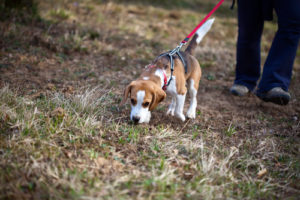While out walking an owner may experience their dog, pulling, gasping, gagging themselves. Loose leash walking with a flat collar seems to be an unobtainable goal. Friends, family, neighbors, strangers on the street all offer meaningful advice on how to handle the situation. Most of the advice may involve the purchase of a harness. Excellent idea, except, there are so many options to choose from, an owner may get overwhelmed.
Go into any pet store whether a big box or a mom and pop shop; an owner is faced with a full section dedicated to harnesses. Usually stretching across an entire wall, a dog lover could stand in awe and nervous anxiety wondering what type to choose for their situation.
Back clip
The back clip harness is dedicated for the ambler; a dog who isn’t in a real hurry to get anyplace in particular, but still eager for the adventure. It should fit snuggly around the waist and torso using the two finger method. If a walker can get two fingers under the harness (works for flat collars too) and move smoothly around it’s a perfect fit. Three fingers are to lose, one finger– too tight.
 Front Clip
Front Clip
The front clip harness is for dogs that need a bit more direction. Those who are eager to wander and explore to the end of their leash and don’t care who they drag behind them to get there. With the front clip harness, the human can gently navigate a walking course with ease. This harness should fit snuggly around the torso and the front chest area. If the harness is slack, a dog will walk right out of it and go exploring alone.
Head collar
Some people unfamiliar with the head collar mistake it for a muzzle. In actuality, the head collar is for the distracted dog who is constantly on the lookout for well… anything. It attaches itself around the head, fits snug behind the ears creating a calming pressure on the dog that gets sidetracked easily. It attaches itself to the flat collar and the leash attaches under the dogs chin. A walker may navigate any path by simply turning the dogs head. Between the calming pressure in back and the front chin steering, a dog will easily follow. The dog can still eat, drink and if need be, bite with the head collar on.
Adjustment Period
As with any harness (especially the head collar) a dog needs time to become accustomed to the new apparatus. Place the harness on the dog, treat, let them know this is a good thing. Do not allow them to paw or wriggle themselves out of it. Give them a couple days, at least, to get used to any harness before trying it on a walk. Allow them to wear it around the house, ten to fifteen minutes at a time, until they appear comfortable and unfazed.
To get the head collar on (most dogs will resist the first few tries). Ensure the collar is ready to snap once it’s in place, put a high end treat in between forefinger and thumb, stick the treated hand through the muzzle end and draw the dog into position. Once the collar is on, snap it in place and treat. Have the dog wear it a couple times a day for no more than five minutes at a time. Treat and praise, let them know this is a good thing.
After the harness has been introduced, yet the walking problems still exist, contact a local trainer. There may be an underlying issue that needs to be resolved.
